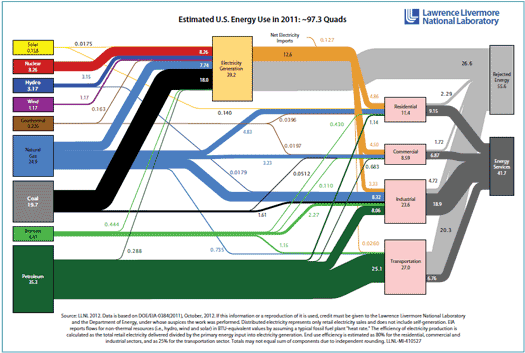High Performance Buildings
Buildings consume 40 percent of the primary energy and 70 percent of the electricity in the U.S. annually.1 Recent advances in building equipment, lighting, sensors, controls, and integrated systems now make it possible to achieve a significant reduction in a building’s energy use, transforming older inefficient buildings into high-performance buildings (HPBs). In addition, through automation, individual buildings and groups of buildings can interact with the power grid to manage peak demand. HPB products make buildings smarter, safer and more efficient while contributing to energy security and creating jobs.
Residential Energy Efficiency
Just as the electric grid, buildings, highways, and factories are getting smarter and more efficient, so are America’s homes. According to the Dept. of Energy, over 50 percent of a typical home’s energy is used for heating and cooling the occupant space, 18 percent to heat water, and 6 percent for lighting.2 Reducing these amounts can significantly reduce the monthly financial burden on homeowners, which strengthens their purchasing power and the overall economy. NEMA Members manufacture Energy Aware™ Programmable thermostats, highly efficient zonal heating systems, lighting controls, smart meters, and home energy management systems that integrate electricity, gas, and water utility distribution with energy storage systems, smart appliances, rooftop solar panels, and electric vehicle charging.
|
Fact: In 2011, the U.S. wasted more energy than it consumed.
Greater Energy Efficiency will boost economic productivity and competitiveness and enhance U.S. energy security.
The chart below shows: U.S. energy sources on the left side in quadrillions of BTUs; their respective contributions to “electricity generation” in the middle box; the amounts of electricity and other sources used by the four categories of energy usage in the pink boxes on the right; and the gross amount of energy used and wasted (“rejected energy”) in the U.S.
NEMA Member manufacturers, covering 50-plus industry sectors, are in the business of electrical products that lead to greater energy efficiency and less waste: a smarter electric grid; high performance buildings in the commercial sector; smart homes in the residential sector; factory automation and control in the industrial sector; and intelligent transportation systems (ITS).
|

Industrial Energy Efficiency
According to the Dept. of Energy, in 2010 the industrial sector used 21 percent of the nation’s total energy consumption, and 23 percent of the nation’s electrical energy.3 When high-efficiency drives and NEMA Premium® motors are combined with sensors, intelligent process controls and monitoring systems, it is estimated that 15- to 30-percent energy savings are attainable in most industrial environments.4 These savings go directly to a company’s bottom line, resulting in more efficient productivity, less cost per unit produced, and lower prices to consumers—all of which improve international competitiveness.
Smart Grid Efficiency
NEMA Members manufacture equipment that will build America’s Smart Grid—a 21st century electric grid that uses information and communications technologies, such as smart meters and high-tech sensors to isolate problems and repair them remotely; recover more quickly from extreme weather outages; and maximize the efficiency, reliability and affordability of electricity. Smart Grid solutions consume less energy through energy storage technologies, microgrids, and combined heat & power (CHP) applications; allow energy-efficient buildings and residences to sell power to the grid, and accommodate a growing number of electric vehicles—all of which contribute to energy efficiency and economic growth.
Intelligent Transportation Systems
The future of transportation and traffic management is at a turning point and NEMA Members are leading the way with high-tech traffic controllers, dynamic messaging signs and advanced traffic signals—in short, intelligent transportation systems (ITS). U.S. energy efficiency, as well as traffic congestion, safety, and the environment, are all improved with deployment of ITS technologies on U.S. highways and high-volume roads. For example, proper signal timing and realtime traffic information reduce volume-related congestion and prevent accidents that lead to more delays. Less congestion means lower emissions, less wasted fuel and higher productivity. In addition, making smarter use of existing capacity means fewer new roads need to be constructed, road-widening becomes less necessary, and more resources are available to ensure physical integrity and safety of existing roads and bridges.
The U.S. currently wastes more energy than it consumes. Greater energy efficiency will boost economic productivity and competitiveness and enhance U.S. energy security. NEMA Members are leading the way on high tech solutions to achieve greater efficiency.
High Performance Buildings: High-efficiency lighting, sensors, and controls; integrated building systems, automation.
Industrial Energy Efficiency: High-efficiency systems involving proper combinations of drives, motors, generators and insulating material; industrial automation and control products; and efficient lighting.
Residential Energy Efficiency: Energy Aware™ Programmable thermostats, zonal heating systems, lighting controls, smart meters and sub-metering, home energy management systems, energy storage systems, electric vehicle charging (EVSE).
Smart Grid Efficiency: Smart meters, sensors, energy storage, micro-grids, combined heating & power (CHP).
Intelligent Transportation Systems (ITS): Traffic controllers, dynamic messaging signs, advanced traffic signals, sensors, detectors, central systems.
Contacts
____________
1 U.S. Dept. of Energy,
Buildings Energy Data Book (2011)
2 U.S. Dept. of Energy,
Buildings Energy Data Book (2011)
3 U.S. Energy Information Administration,
Annual Energy Review (2011)
4 Collated from Siemens, Eaton, and Rockwell case studies.